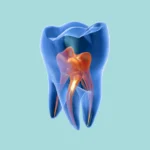Imagine this, doctor: a patient walks into your clinic complaining of a long-standing, persistent obstruction in one nostril. They’ve tried every allergy medication and nasal spray available, yet there’s been absolutely no improvement. While performing a routine panoramic radiograph to check on their teeth, you suddenly spot a rounded, radiopaque mass situated precisely above the roots of the maxillary teeth, right within the nasal cavity.
What exactly is this peculiar finding? And could it possibly be connected to your patient’s primary complaint? Let’s delve into it.
What Exactly is a Rhinolith?
Simply put, doctor, a rhinolith is a calcified mass that forms and grows inside the nasal cavity. Think of it much like a kidney stone, but this one happens to be located in the nose.
Identifying It on Radiographs: Key Features (Radiographic Features)
To quickly identify a rhinolith on radiographs, focus intently on these characteristic features:
Location
Naturally, its primary location is within the nasal cavity. On a panoramic radiograph (pantomograph), you’ll typically observe it appearing superior to the nasal cavity floor.
Edge
Its borders are usually well-defined. The outer outline can present as either smooth or somewhat irregular.
Shape
The shape of a rhinolith is quite variable; you might find it to be round, ovoid, or even markedly irregular.
Internal Composition
Internally, it appears distinctly radiopaque. A particularly telling feature is that it sometimes presents with a laminated appearance—meaning you might observe alternating layers that are radiopaque and then radiolucent. This layered morphology often resembles the concentric layers of an onion, and it develops due to the gradual deposition of calcium salts over time.
Number
In the vast majority of cases, a rhinolith is typically single.
Key Diagnostic Signs
The two most crucial signs that will enable a confident diagnosis are:
-
The unmistakable presence of a radiopaque mass within the nasal cavity.
-
The potential, though not always present, for a laminated internal structure.
Clinical Significance
The presence of a rhinolith isn’t merely an incidental finding on a radiograph; it can genuinely cause several problems for the patient, such as:
-
Nasal obstruction.
-
Persistent nasal discharge.
-
A foul odor.
If left unaddressed and untreated, it can progress to more serious conditions like sinusitis or other various complications. Consequently, its removal becomes absolutely essential in cases where it is causing significant symptoms for the patient.
An Important Diagnostic Note
Before you consider referring the patient for a cone-beam CT (CBCT) scan, it can be very beneficial to perform a standard maxillary occlusal radiograph. This simple radiograph can significantly aid you in precisely localizing the rhinolith. Differentiating it accurately from any other calcified masses in this region is paramount to ensuring an appropriate and effective treatment plan.




















